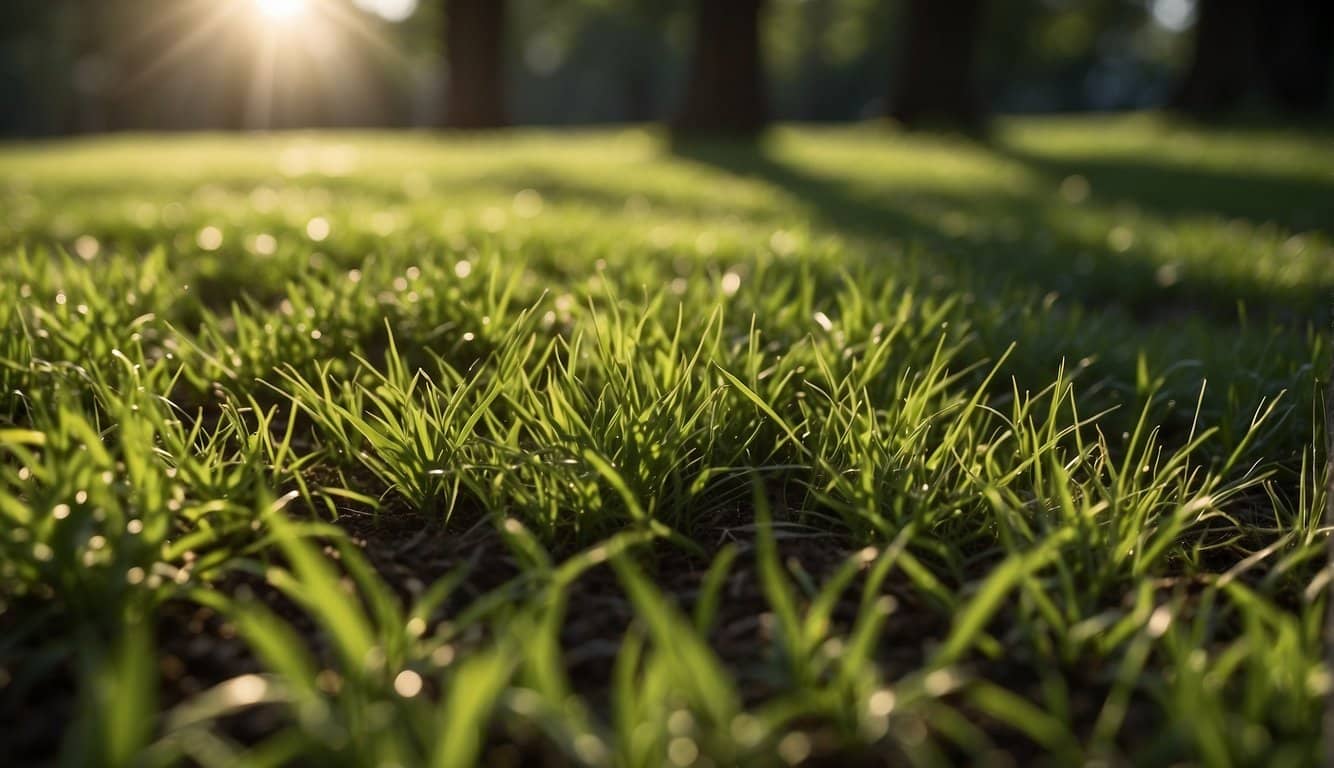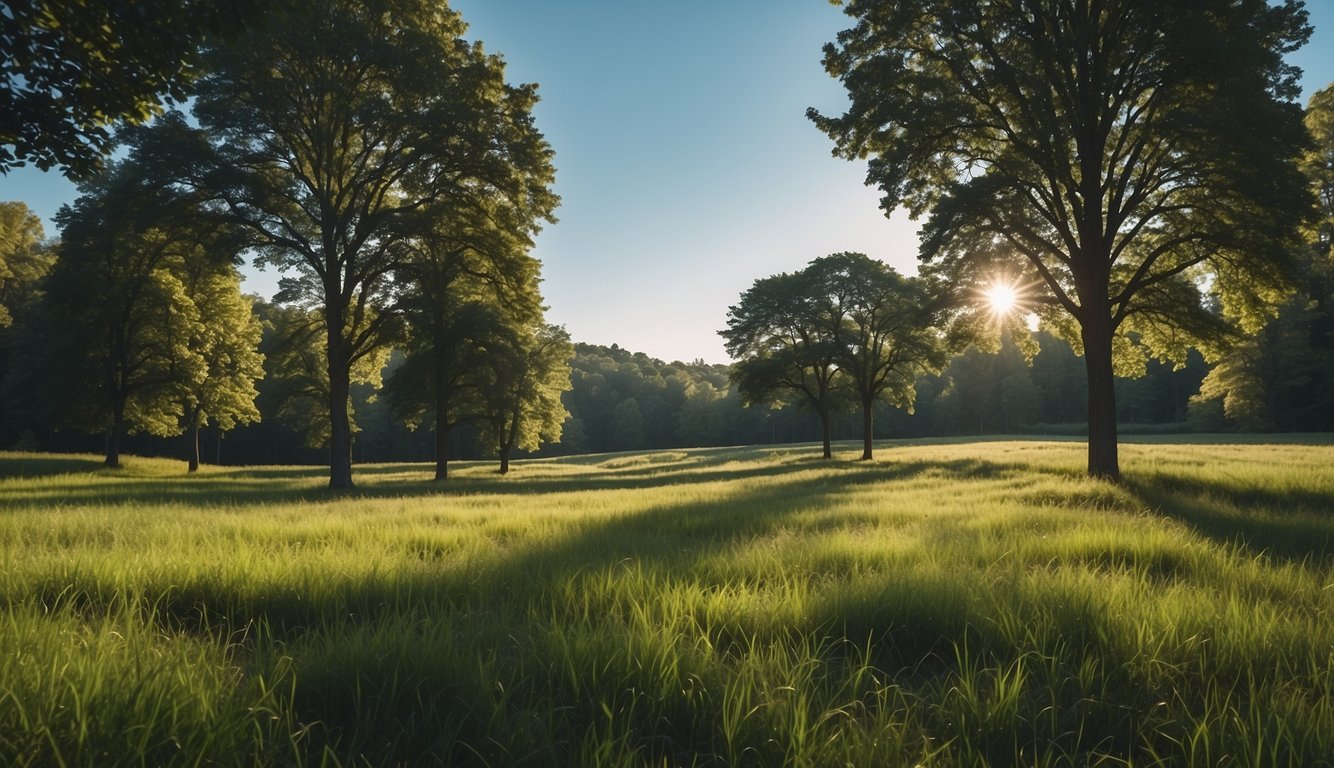Shade-Tolerant Grass Seeds: Solutions for Low-Light Lawns
Creating a lush, green lawn in areas where sunlight is a rare visitor can be a challenge. Shade-tolerant grass seeds are your solution, offering a tailored approach to ensure your lawn stays verdurous even in low-light conditions.
Types of Shade-Tolerant Grasses
Choosing the appropriate grass seed for shaded areas is crucial for a healthy lawn. Here’s a list of shade-tolerant grasses to consider:
- Fine Fescue: Thrives in cool climates with moderate to heavy shade.
- St. Augustine: Known for its ability to prosper in warm, shady environments, St. Augustine grass is a popular choice.
- Zoysia Grass: Zoysia does well with minimal sunlight and provides a dense, durable lawn. For as little as three hours of direct sun exposure, Zoysia grass can maintain its vibrant color, making it an ideal warm-season turf grass for shaded lawns.
- Poa Bluegrass: Although sometimes classified as a weed, this resilient grass excels in high shade conditions.
Each variety has its specific light and care requirements, ensuring that you can find the perfect match for your yard’s unique shade profile.
Benefits of Shade-Tolerant Varieties
Shade-tolerant grass seeds provide a multitude of benefits:
- Reduced Sunlight Requirements: Allows for a verdant lawn even in areas that receive minimal direct sunlight.
- Adaptability: These grasses have adapted to flourish with lower photosynthetic activity, which translates into a robust lawn under trees or next to buildings.
Investing in the right shade-tolerant grass variety turns a potential eyesore into a lush, inviting garden space. It’s about choosing the species that align with your climate and shaded area characteristics to ensure a vibrant lawn.
Planting Strategies for Low-Light Lawns
Crafting a verdant lawn in areas where sunlight is scarce requires specialized techniques focusing on soil preparation and seeding methods. These ensure that the grass can establish itself and thrive despite the reduced light.
Preparation of Soil for Shady Areas
- Test the Soil: Before planting, get your soil tested to check for pH levels and nutrient content. The ideal pH for most grass types is between 6.0 and 7.0. If necessary, apply lime to raise pH or sulfur to lower it to reach the optimal range.
- Improve Soil Structure: Aerate compacted soil to enhance root growth and water penetration. This is particularly pivotal in shady areas where soil tends to retain moisture.
- Organic Matter: Integrate generous amounts of organic compost into the top 4 to 6 inches of soil. This amends the soil, improving drainage and providing essential nutrients.
Seeding Techniques for Optimal Growth
- Seed Selection: Choose seed mixes specifically designed for shade, such as fine fescues or shade-tolerant varieties of ryegrass.
- Seeding Time: The best time for seeding is early fall or spring. This coincides with cooler temperatures and natural rainfall, aiding seed germination.
- Application Rate: Apply the seed at the recommended rate on the package; overseeding can lead to crowded growth and increase the likelihood of disease.
- Seed-to-Soil Contact: Rake lightly after seeding to ensure the seed makes good contact with the soil, which is critical for germination.
- Consistent Moisture: Keep the soil consistently moist but not waterlogged until seeds germinate and the grass establishes. Use fine mist sprays to avoid washing away the seeds.
Maintenance and Care for Shade-Tolerant Lawns
Maintaining a lush, healthy lawn in shaded areas requires specific practices for watering and fertilizing. Ensuring that your lawn receives the appropriate amount of each, avoiding excesses and shortages, is key to fostering strong growth even in low-light conditions.
Watering Practices for Shaded Grass
Your lawn in the shade doesn’t need as much water as the parts bathed in sunlight—reduced evaporation rates mean moisture lingers longer. Follow these guidelines:
- Frequency: Water less often, allowing soil to dry slightly between sessions.
- Amount: Aim for about an inch of water per week, increasing slightly during dry spells.
Monitor shaded areas for overwatering, as this promotes fungal growth and can weaken grass roots.
Fertilizing Shaded Lawns Appropriately
Fertilization encourages healthy growth but takes a careful hand under the canopy. Here’s what you need to know:
- Timing: Apply fertilizer early spring or fall to coincide with natural growth cycles.
- Products: Opt for a slow-release, nitrogen-rich fertilizer to nourish without overwhelming.
Remember to apply fertilizer sparingly in shaded areas compared to sunlit sections, as shade-tolerant grasses grow slower and require less. Use the directions on your specific grass blend for the best results, and consider a soil test every few years to tailor your fertilization program to your lawn’s needs.
Common Issues
Growing grass in shaded areas presents unique difficulties, but with the right knowledge and strategies, you can cultivate a healthy and lush lawn. Let’s explore specific issues and their effective solutions.
Dealing with Patchy Growth
- Evaluate Soil Quality: To address patchy areas, first ensure your soil is healthy. Conduct a soil test and amend the soil with necessary nutrients or soil conditioners.
- Select Shade-Tolerant Varieties: Utilize grass seeds suitable for shade, like fine fescues, that thrive despite limited sunlight.
- Regular Overseeding: Help maintain lawn density by overseeding affected areas periodically to encourage new growth.
Preventing Disease in Low-Light Conditions
- Improve Air Circulation: Trim overhanging branches to facilitate airflow, reducing the potential for fungal diseases, which is a common problem in shady and moist conditions.
- Opt for Disease-Resistant Seeds: Choose seed mixes that tout disease resistance, effectively minimizing the risk of common turf diseases in shaded lawns.
Frequently Asked Questions
Navigating the challenges of cultivating a lush lawn in the shade is simpler with the right knowledge and selection of grass seeds.
What varieties of grass seed are most effective for shady lawns?
For shady lawns, fine fescue and Kentucky bluegrass have proven effective due to their tolerance to lower light conditions. Combining these varieties often results in the best coverage.
How can you successfully grow grass in shaded areas with poor soil?
To succeed in growing grass in shaded areas with poor soil, start by improving soil quality with compost and choose shade-tolerant grass such as ryegrass or specific fescue varieties that adapt well to less fertile conditions.
Which grass seeds are ideal for southern lawns with limited sunlight?
Southern lawns with limited sunlight benefit from St. Augustine grass, which tolerates both heat and shade. Additionally, Zoysia grass can perform well under these conditions given its resilience.
Can grass grow well in dense shade, and if so, what type should be used?
Grass can grow in dense shade, but success is highly dependent on selecting the right type of grass. Scotts Turf Builder Grass Seed Dense Shade Mix is one selection specifically tailored for these challenging conditions.
What steps should be taken to cultivate grass in shaded areas beneath trees?
To cultivate grass in shaded areas beneath trees, follow these steps:
- Thin out tree branches to allow more sunlight to reach the ground.
- Use a shade-tolerant grass seed mix that includes fine fescue or St. Augustine.
- Take extra care with watering and fertilizing, adhering to the specific needs of the chosen grass type.
How does Zoysia grass seed perform in low-light environments?
Zoysia grass seed is recognized for its shade tolerance, making it a suitable choice for low-light environments.
Its ability to establish deep root systems helps it endure shaded conditions better than many other grass species.
Last update on 2025-06-06 / Affiliate links / Images from Amazon Product Advertising API




